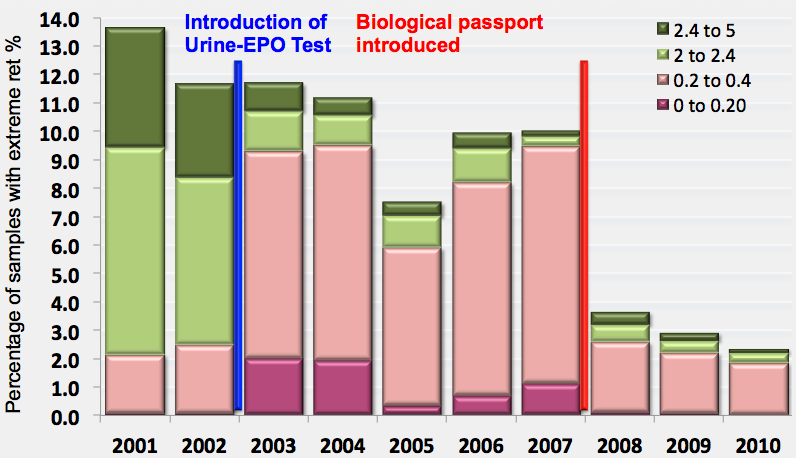I wonder when you think the teams started doing blood transfusions (after EPO was introduced)?. Hamilton pretty much stated that US Postal started in 2000 -- I guess it was because they had heard rumors about an EPO test being on the steps, and didn't want to take any chances. And one would think the other teams would soon follow when the EPO test actually was introduced.
...but in 2006 Operacion Puerto came to light, and implicated riders from almost all of the bigger teams. One conclusion to draw from this would be that these teams didn't have an organized program for blood transfusions. But you guys might disagree? The obvious exception would of course be Kelme who had worked with Fuentes a long time, and maybe ONCE/Liberty Seguros who seemed to work with Fuentes on a more team level.
The common conception seems to be that most of these riders started working with Fuentes relatively early prior to Operacion Puerto broke. So what did they do before that? And why did really all of these people go to the same doctor?
I don't know many incidents regarding blood transfusions before Operacion Puerto (non US Postal). There is the precursor to Puerto...the confessions of Jesús Manzano who said he'd been doing autologous blood doping back in 2003. This was probably the legacy of Fuentes (as far as I know, Fuentes wasn't the team doctor at this moment), so we could guess that Kelme started a bit before then.
Another incident is a supposed phone call between Bogdan Madejak and Cofidis rider Marek Rutkiewicz before the latter was busted at the airport with "banned substances". There they talk about about "a new method" when they are referring to blood transfusions. I this this conversation was from 2003, but I'm not sure.
Then we have Tyler Hamilton and Santiago Pérez who managed to get caught for (homologous) blood transfusions. How this happened we can only wonder. But Hamilton is also linked to Fuentes. Then we have Floyd Landis, who said that he contacted Del Moral to help him with the blood doping after he quit US Postal and joined Phonak.
So What are your thoughts? When did blood transfusions start to become the doping method of choice in the bigger races? When did the teams start adopting it?
...but in 2006 Operacion Puerto came to light, and implicated riders from almost all of the bigger teams. One conclusion to draw from this would be that these teams didn't have an organized program for blood transfusions. But you guys might disagree? The obvious exception would of course be Kelme who had worked with Fuentes a long time, and maybe ONCE/Liberty Seguros who seemed to work with Fuentes on a more team level.
The common conception seems to be that most of these riders started working with Fuentes relatively early prior to Operacion Puerto broke. So what did they do before that? And why did really all of these people go to the same doctor?
I don't know many incidents regarding blood transfusions before Operacion Puerto (non US Postal). There is the precursor to Puerto...the confessions of Jesús Manzano who said he'd been doing autologous blood doping back in 2003. This was probably the legacy of Fuentes (as far as I know, Fuentes wasn't the team doctor at this moment), so we could guess that Kelme started a bit before then.
Another incident is a supposed phone call between Bogdan Madejak and Cofidis rider Marek Rutkiewicz before the latter was busted at the airport with "banned substances". There they talk about about "a new method" when they are referring to blood transfusions. I this this conversation was from 2003, but I'm not sure.
Then we have Tyler Hamilton and Santiago Pérez who managed to get caught for (homologous) blood transfusions. How this happened we can only wonder. But Hamilton is also linked to Fuentes. Then we have Floyd Landis, who said that he contacted Del Moral to help him with the blood doping after he quit US Postal and joined Phonak.
So What are your thoughts? When did blood transfusions start to become the doping method of choice in the bigger races? When did the teams start adopting it?






